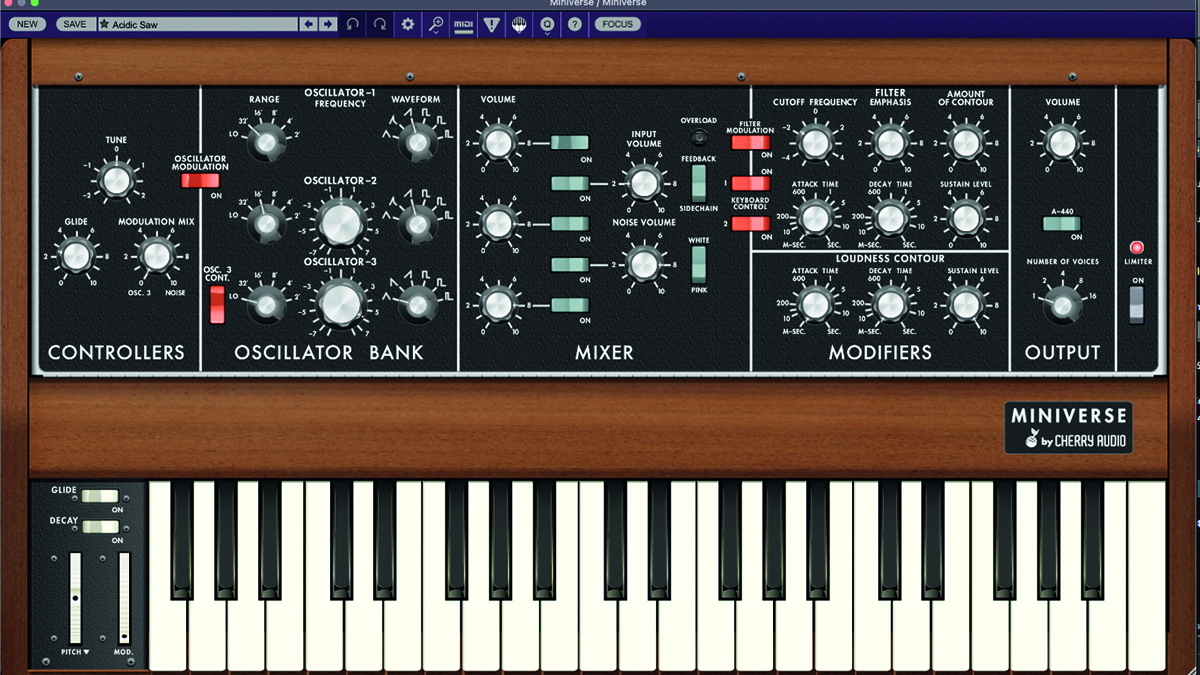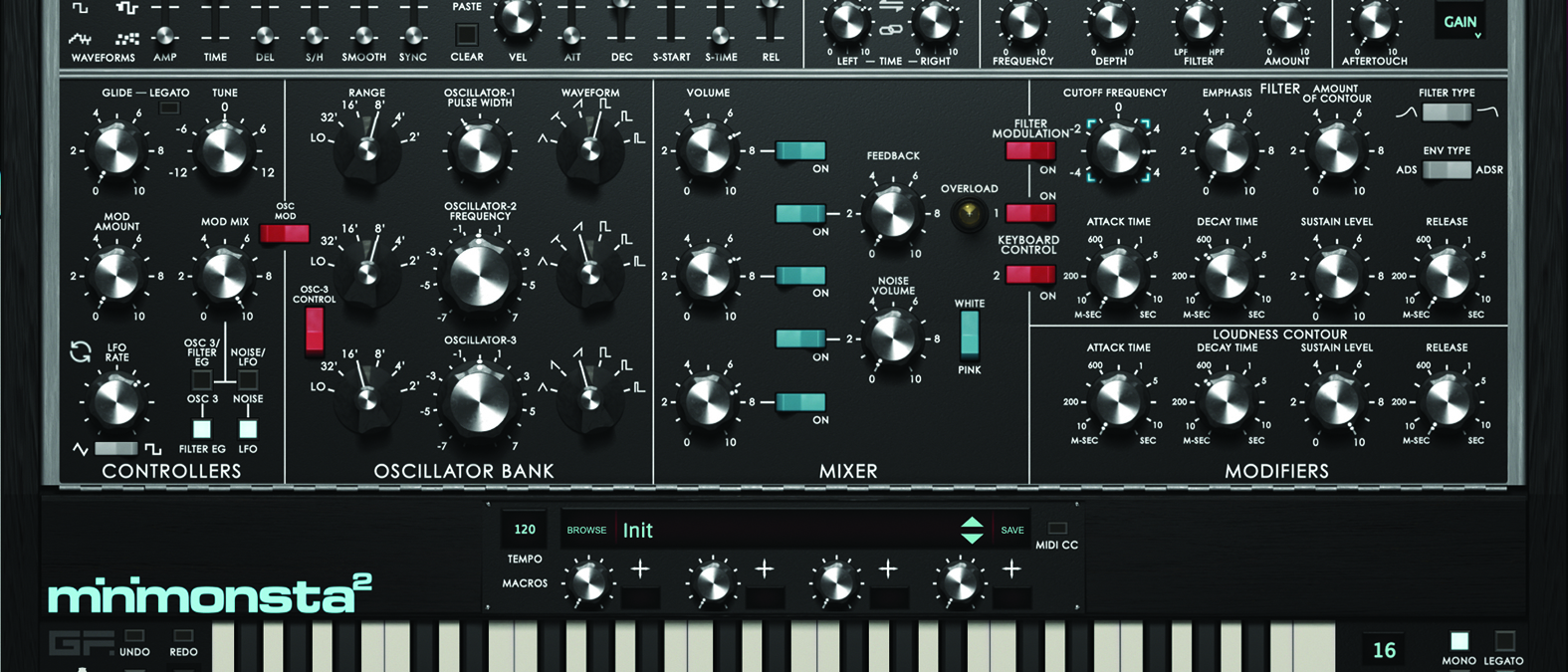MusicRadar Verdict
With a market full of Mini-remodels, this is a sizeable update with major enhancements. Packed full of vintage and modern charm!
Pros
- +
Huge sounding.
- +
16-note polyphonic Minimoog!
- +
Velocity and Aftertouch easy to engage.
- +
The new Modern filter sounds perfect.
- +
Remodelled patch browser is top-notch.
- +
Sharp-looking and sounding.
Cons
- -
What’s not to like?
MusicRadar's got your back
GForce Software Minimonsta2: What is it?
The mere mention of the Minimoog will bring a smile to the faces of most musically-minded people. But, there are times when you want just that little bit more. GForce Software is on hand to provide and deliver a Mini, with a hell-of-a-lot more.
We love the original Minimoog, and with plenty of great reimaginings in the software domain, we’re rather spoilt for choice.
If you’re only interested in the basics, you will not be disappointed; a quick trip to the preset patch browser reveals the Init Patch button, which will reduce this plugin to its barest essentials and a good place to start our critique; the architecture is reassuringly familiar to all who’ve previously used a Minimoog, with three oscillators providing the initial heavy lifting.
There are six waveforms, with a new Pulse Width control, which is hard-wired to Oscillator 1, for use with the square/pulse waves.
This takes the place of the tuning pot, which remains in place for Oscs 2 and 3 for fine or hard tuning against Osc 1. Each oscillator also provides triangle, saw and shark-tooth waveforms, with a 5-octave range pot.
A further sixth pot-position provides ‘Lo’, should you feel you need to be traditional with your LFO modulation, spawned from a regular oscillator.

GForce Software Minimonsta2: Performance and verdict
At the mixer stage, you’ll find Noise, in both pink and white variations, and a dedicated Feedback loop, providing the virtual equivalent of routing the headphone output into the external input.
Want all the hottest music and gear news, reviews, deals, features and more, direct to your inbox? Sign up here.

• Cherry Audio Miniverse
Amazing value, this is an accurate recreation of the Mini, in a stylish GUI and package.
• Universal Audio Moog Minimoog
One of the most authentic Mini clones-in-software, now available in a native plugin format.
So far so good, but now we get to some subtle deviations, beginning with the filter section. GForce makes the point that the original Moog 24dB ladder filter is a thing of pure sonic joy, but it suffers from the ubiquitous issue of losing bottom-end, when the resonance is increased. You can attempt to place this back in the signal, through distortion, but while the original filter type is included, you can also switch to a more modern iteration, which rebalances this issue sonically. As you switch from Original to Modern, the change in tonal colour is very obvious, as the lower-mids kick in.
On a similar tack, you’ll find dedicated envelopes for amplitude (loudness) and filter cutoff. Traditionally, these would be 3-stage, providing ADS phases, but you can now switch to a 4-stage ADSR if you prefer. The ADS envelopes are always characterful on a Mini, but it’s very nice to have the option.
From trad to modern
In its initialised form, there’s depth to the sonic makeup, making it indistinguishable from the real McCoy, but the undoubted Minimonsta2 calling card is its ability to go significantly further in editing.
At the basic end of business, you’ll find a Vintage knob, which can be increased to induce vintage-style characteristics when tuning. There’s also a new back-end Matrix Reverb, with five different reverb styles, from Slapback to Huge. Couple these with the reverb’s modulation and filter, and it sounds exceptionally musical.
The new Macro feature allows the programming of four macro pots, for controlling multiple pot-values from a single location. These are easily assigned, through clicking/dragging, and can also be assigned to velocity and aftertouch, for enhanced performance control.

All in the X-Modifiers
One of the many additions to the Minimonsta form can be located in the upper portion of the plugin window. The XLFO and XADSR sections allow cross modulation. Drawn from either dedicated LFOs or envelopes, the LFOs will also sync to your DAW. However, if this ability doesn’t interest you, the handy Retract button removes these parameters from view, along with the effects and performance controls, at which point the Minimonsta2 adopts a panorama nearly identical to an original Mini.
The final Patch
Minmonsta 2 is a truly magnificent synth; it provides all of the character of the original Mini, but with plenty of capacity for modern control. It’s also polyphonic, to the tune of 16 voices, which means that you can also go to a state of fully detuned unison, and if that’s not enough, the superb collection of 800 patches will certainly keep you inspired. It will which will keep you coming back for those production-ready sounds on a regular basis.
MusicRadar verdict: With a market full of Mini-remodels, this is a sizeable update with major enhancements. Packed full of vintage and modern charm!
GForce Software Minimonsta2: The web says
"It has the punch and lightness of touch which makes the hardware so wonderful. Minimonsta 2 can kick ass and take numbers, but it can also caress and seduce you with warm lush tones."
Gearnews.com
GForce Software Minimonsta2: Hands-on demos
GForce Software
sonicstate
VST'S SOUNDS
ZozillaThaGreat
GForce Software Minimonsta2: Specifications
- macOS 10.13 or above. Intel or Apple Silicon Mac. Standalone application, AudioUnit, AAX, VST2, VST3.
- Windows 7 and above. 2GHz CPU with 2GB RAM. Standalone Application, VST, VST3, AAX.
- CONTACT: GForce Software
Computer Music magazine is the world’s best selling publication dedicated solely to making great music with your Mac or PC computer. Each issue it brings its lucky readers the best in cutting-edge tutorials, need-to-know, expert software reviews and even all the tools you actually need to make great music today, courtesy of our legendary CM Plugin Suite.

